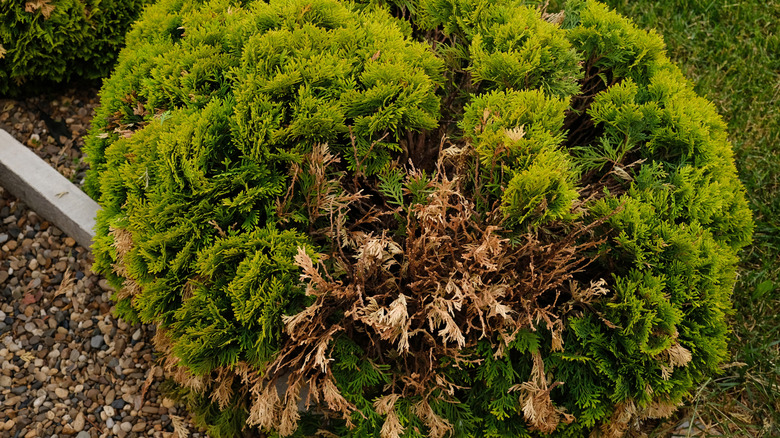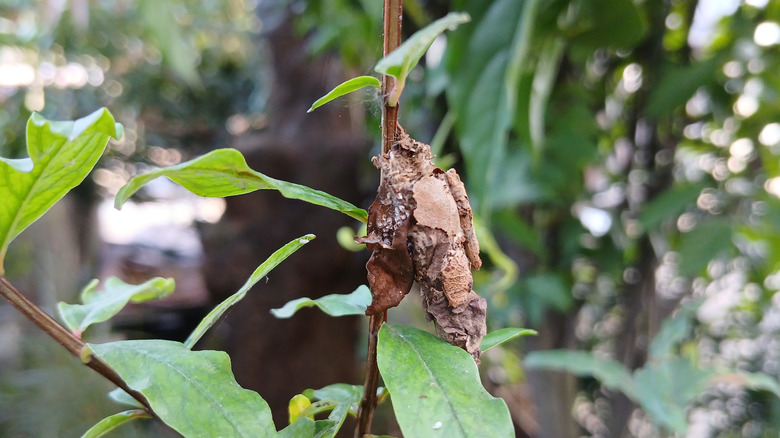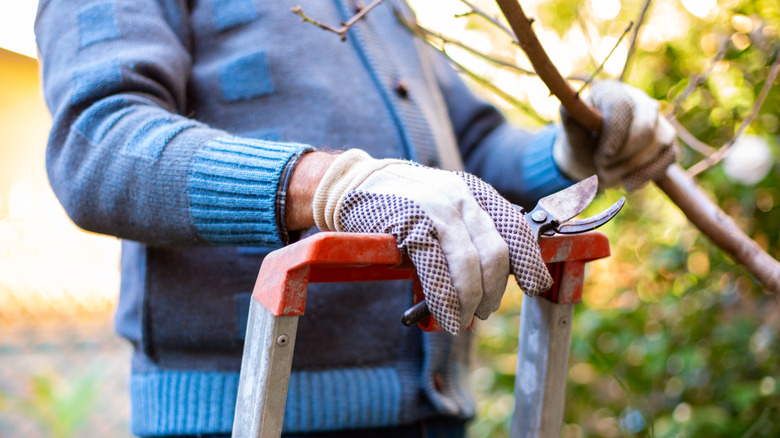The Stealthy And Destructive Pest Ohio Locals Should Be On High Alert For
If the trees and shrubs around your gardens are looking a bit worse for wear — with browning leaves, bare branches, or they're just not bouncing back from winter — you certainly aren't alone. While environmental stressors like drought and disease may spring to mind, the real culprit might just be hiding in plain sight. Many Ohio homeowners are surprised to learn that their greenery is being ravaged by a pest known as bagworms. These small, caterpillar-like pests are notoriously difficult to detect until they've caused significant damage to your outdoor spaces. And by the time your plants are showing symptoms, there might already be a full-scale invasion happening under your nose.
Bagworms may not seem like a major threat to your greenery at first, but their impact can be surprisingly severe. It should be noted that bagworms are not considered an invasive species, but they can be one of the worst pests that you will need to banish from your garden. This is because each batch of bagworms typically holds anywhere from 500 to 1000 eggs. What's more, their protective casings—made from silk and bits of surrounding foliage—blend right into your landscaping. This camouflage allows them to spread quickly, and often unnoticed, feeding on leaves and branches until trees and shrubs are visibly compromised. It is important for homeowners, in Ohio especially, to be aware of their presence and learn the techniques to handle a bagworm population, since the threat of an outbreak has been warned in the state.
The impact of these destructive bugs
It might be difficult to notice the early signs of a bagworm infestation, but it is the most important step in protecting the greenery around your home. An unchecked population of these pests may be the reason that your conifer trees and shrubs are browning, as hearty species struggle with foliage loss. While the damage typically starts small, with a few notches on a leaf or some light browning, it can quickly grow completely out of control. These pests can cause some major damage to your trees, as newly hatched larvae eat nearby leaves in order to grow. As they continue to mature, their feeding intensifies, and they can leave your greenery looking noticeably stressed. The damage is typically visible around late summer when the larvae have been growing throughout the season.
Although the spread of bagworms is typically not very fast, with only about one generation per year, they are surprisingly efficient. Female bagworms never develop wings like other species of moth, instead spending their time in their bags. Males, however, often fly to meet female bagworms and reproduce. This can lead to a serious infestation on their preferred plants, completely stripping them of foliage in the process. The damage caused by bagworms may take several seasons for the plant to recover from, so it is best to handle these pests before they get out of control. If you start to notice yellowing or browning leaves on even your hardiest of outdoor plants, you may want to check for a thriving bagworm population. With a few different methods, you can ensure healthy greenery around your home.
Managing a bagworm outbreak
The most effective way to deal with bagworms is to stop them before they have a chance to hatch. From late fall to early spring, you can inspect your trees for the distinctive spindle-shaped bags. These are constructed by female bagworms and often protect their offspring during the winter. The bags themselves are fairly small, typically only a few inches long, and dangle off branches in a similar way to pinecones. You can remove them using a pair of gardening shears or by hand, sealing them in a plastic bag for disposal. This will prevent hundreds, if not thousands, of larvae from emerging once the weather starts to warm. It is also the only chemical- and pesticide-free means of dealing with these pesky invaders. This approach is especially helpful for homeowners with a smaller infestation or those who prefer a pollinator-friendly garden. Just be aware that leaving even a few bags can restart the cycle in a few years.
If you haven't been able to tackle your bagworm infestation before the pests have hatched, there are still a few approaches that you can employ around your yard. The first involves a specific insecticide known as Bacillus thuringiensis, a bacterium that targets freshly hatched larvae. The insects eat the bacteria off nearby greenery, become sick, and eventually die off. It is best to use this method as the bagworms start to hatch in the late spring. You can alternatively use a few chemical forms of pest control, like acephate, cyfluthrin, or spinosad. These chemicals are most effective when used on young larvae, as bagworms become more resistant as they grow.


